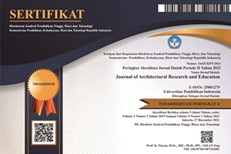ANALYSIS OF THE CORRELATION OF POPULATION GROWTH TO FULFILLMENT OF THE SUPPORT CAPACITY OF EDUCATIONAL FACILITIES IN SUKABUMI DISTRICT (CASE STUDY OF CISAAT DISTRICT AND SURADE DISTRICT)
Abstract
Keywords
Full Text:
PDFReferences
Cynthia, L. C., Martono, T., & Indriayu, M. (2016). Pengaruh Fasilitas Belajar Dan Motivasi Belajar Terhadap Prestasi Belajar Mata Pelajaran Ekonomi Siswa Kelas XII IS Di SMA Negeri 5 Surakarta Tahun Ajaran 2015/2016. Jurnal Pendidikan Bisnis Dan Ekonomi, 1(2).
Huisman, H. (1987). Perencanaan Pelayanan dan Pusat Pelayanan. RRDP Series Number VII.
Indonesia, R. (2017). Permendikbud Nomor 17 Tahun 2017 tentang Penerimaan Peserta Didik Baru pada Taman Kanak Kanak. Sekolah Dasar, Sekolah Menengah Pertama, Sekolah Menengah Atas, Sekolah Menengah Kejuruan atau bentuk Lain yang sederajat.
Kaiser, E. J., Godschalk, D. R., & Chapin Jr, F. S. (1995). Urban Land Use Planning, 4" Edition. Urbana and Chicago: University of Illinois Press.
Nasional, D. P., & No, P. M. P. N. (2007). 24/2007 tentang Standar Sarana dan Prasarana untuk SekolahDasar. Madrasah Ibtidaiyah (SD/MI), Sekolah Menengah Pertama/Madrasah Tsanawiyah (SMP/MTs) dan Sekolah Menengah Atas/Madrasah Aliyah (SMA/MA), Jakarta.
Sarwono, J. (2006). Metode penelitian kuantitatif dan kualitatif.
Uliantoro, W. G. (2011). Perencanaan Fasilitas Pendidikan Kawasan Perkotaan. Jurnal Ilmu Administrasi: Media Pengembangan Ilmu dan Praktek Administrasi, 8(3), 09.
Yeates, M., & Garner, B. (1980). The north american cities. Ontario: Queen.
DOI: https://doi.org/10.17509/jare.v4i2.55681
Refbacks
- There are currently no refbacks.
Copyright (c) 2023 Journal of Architectural Research and Education

This work is licensed under a Creative Commons Attribution-NonCommercial-ShareAlike 4.0 International License.
Statcounter

This work is licensed under a Creative Commons Attribution-ShareAlike 4.0 International License.








